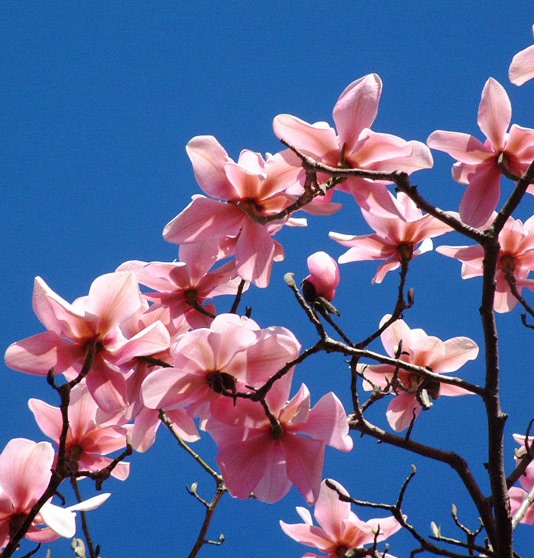I love "Magnolias" and while I'm learning more about them................
Flowers bloom from April to June, but in general the trees do not begin blooming until their seventh year.
Umbrella Magnolia is a small tree to 40 feet in height that can be distinguished by its very large leaves, which are 10-24 inches long by 6-9 inches wide. It is a rare tree found along the banks of rivers and streams in moist, fertile soil. The large flowers, which apperar in May, are creamy-white and 6-10 inches across with an unpleasant fragrance. Its only location in Indiana is in a ravine in a south-central border county.
I'm
far from being an expert. I'm not a horticulturist or a botanist or a
nursery owner. I just love looking and collecting photographs of them.
All that I know I've learned from reading and from personal experience.
I love to learn more about things which I like then write about them, so by nature I do research.
Magnolia
is a large flowering plant species in the subfamily Magnolioideae of
the family Magnoliaceae The natural range of Magnolia species is rather
scattered and includes eastern North America , Central America and the
West Indies and east and southeast Asia, Some species are found in South
America, Today many species of Magnolia and an ever increasing number
of hybrids can also be found as ornamental trees in large parts of North
America, Europe, Australia and New Zealand.
The genus is named after French botanist Pierre Magnol ,
Magnolia is an ancient genus. Having evolved before bees appeared, the flowers developed to encourage pollination by beetles . As a result, the carpels of Magnolia flowers are tough, to avoid damage by eating and crawling beetles. Fossilised pecimens of M. acuminata have been found dating to 20 million years ago, and of plants identifiably belonging to the Magnoliaceae dating back to 95 million years ago. Another primitive aspect of Magnolias is their lack of distinct sepals or petals. The term tepal has been coined to refer to the intermediate element that Magnolia has instead. Magnolias are used as food plants by the larvae of some Lepidoptera species including Giant Leopard Moth.
Magnolia grandiflora is a large evergreen tree which will grow 30 meters tall and 1.8 meters in trunk diameter
Twigs: Covered with rust colored hairs when young, but become smooth and stay rusty with age
Flower: Each 17.5 to 20 cm across with 6 to 12 petals which are creamy white, light & dark Pink, Deep Magenta, Yellow & Peach, Each flower is on a stout hairy stalk. They are very fragrant and appear in late spring and early summer
The genus is named after French botanist Pierre Magnol ,
Magnolia is an ancient genus. Having evolved before bees appeared, the flowers developed to encourage pollination by beetles . As a result, the carpels of Magnolia flowers are tough, to avoid damage by eating and crawling beetles. Fossilised pecimens of M. acuminata have been found dating to 20 million years ago, and of plants identifiably belonging to the Magnoliaceae dating back to 95 million years ago. Another primitive aspect of Magnolias is their lack of distinct sepals or petals. The term tepal has been coined to refer to the intermediate element that Magnolia has instead. Magnolias are used as food plants by the larvae of some Lepidoptera species including Giant Leopard Moth.
Magnolia grandiflora is a large evergreen tree which will grow 30 meters tall and 1.8 meters in trunk diameter
Twigs: Covered with rust colored hairs when young, but become smooth and stay rusty with age
Flower: Each 17.5 to 20 cm across with 6 to 12 petals which are creamy white, light & dark Pink, Deep Magenta, Yellow & Peach, Each flower is on a stout hairy stalk. They are very fragrant and appear in late spring and early summer
Fruit:
"Cylindrical cone 3 to 4 inches (7.5-10 cm) long, purplish, turning
rusty-brown with bright red, shiny seeds hanging from filamentous
threads when mature in September and October"
Bark:
Gray to brown coloring, smooth when young but becomes lightly furrowed
into close, flat plates or scales,Bark is fragrant and bitter.
Form:
"Dense, upright, pyrimidal form in sunlight for first 15 to 20 years
becoming more irregular with advanced age. Loose open density in shade"Flowers bloom from April to June, but in general the trees do not begin blooming until their seventh year.
Umbrella Magnolia is a small tree to 40 feet in height that can be distinguished by its very large leaves, which are 10-24 inches long by 6-9 inches wide. It is a rare tree found along the banks of rivers and streams in moist, fertile soil. The large flowers, which apperar in May, are creamy-white and 6-10 inches across with an unpleasant fragrance. Its only location in Indiana is in a ravine in a south-central border county.





















